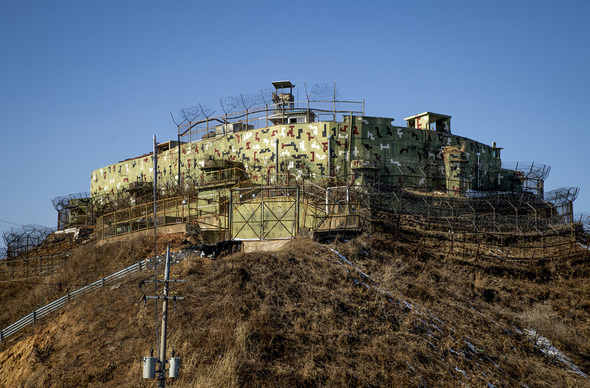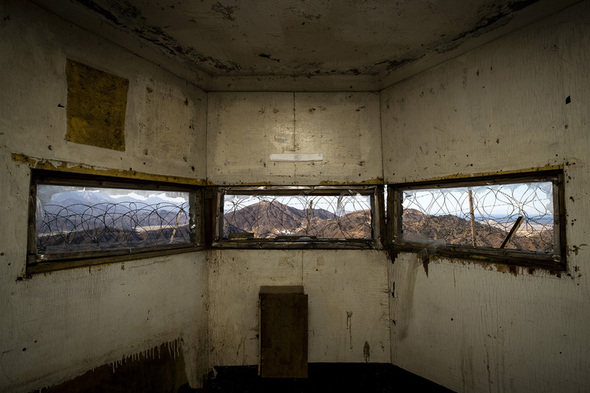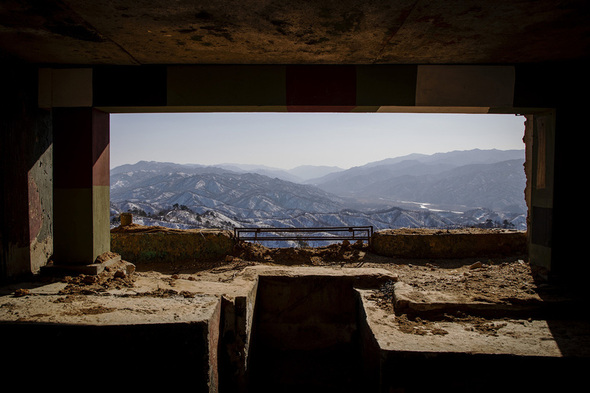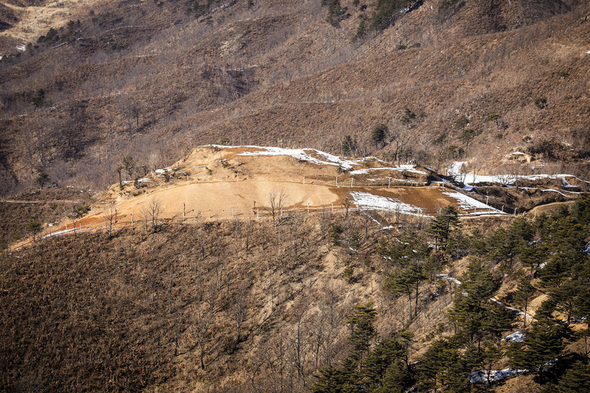Posted on : Feb.15,2019 15:18 KST
 |
|
he Ministry of National Defense opened to the news media the DMZ guard post (GP) it selected for historical preservation in Goseong, Gangwon Province, on Feb. 13. The Sept. 19 inter-Korean Comprehensive Military Agreement in 2018 stipulated that 11 GPs on both the South and North Korean sides of the DMZ be demolished, and one post on each side be preserved. (photo pool)
|
A look inside the oldest GP on the South Korean side
There was a lock on the iron door leading into the fortress. The barbed wire fencing surrounding the site was brown with rust, after 67 years of wind and rain.
This Guard Post (GP) in Goseong County, Gangwon Province, is being preserved for its historical value. Located at the northernmost point of South Korean territory, it’s the oldest of the GPs built along the DMZ (demilitarized zone) between South and North Korea. From the conclusion of the Korean Armistice Agreement in 1953 until the GP was closed as part of the inter-Korean military agreement on Sept. 19, 2018, South Korean troops stationed here kept their guns aimed toward North Korea.
Passing into the part of Goseong that’s off-limits to civilians and crossing the barbed wire fence, you can reach the DMZ. Since the armistice, over 60 GPs have been built on the South Korean side of the DMZ and over 160 on the North Korean side. As part of the inter-Korean military agreement, South and North Korea each removed firearms, equipment and troops from eleven of these GPs during October and November 2018. But the two sides agreed to each leave one GP standing in light of their historical significance. South Korea selected the GP at Goseong, which is located at an elevation of 340m. This GP is barely 300m from the military demarcation line, and just 580m from a North Korean GP on the other side.
“Shouting at the South Korean guard post could be heard on the North Korean side,” said a staff member responsible for preserving the GP. South Korea’s military gave the press its first peek at this GP on Feb. 13. The Hankyoreh was on hand to take a look around the grounds.
 |
|
The GP’s windows have been torn out.
|
After passing through the barbed wire in front of a general outpost and driving down a gravel road for about 3.4km, the preserved guard post comes into sight, looking rather like an old castle. On the day of the visit, there was a wind chill of 11C below zero. The GP stood alone in the brisk ocean wind, shorn of its garrison and armaments. A stoutly locked iron door was opened, revealing the chill within. My jaw dropped to see the arms depot, which had once been full of weapons and ammunition – the blackened space was completely empty.
Until the troops were withdrawn from this guard post in October and November 2018, a platoon of between 30 and 40 soldiers had been stationed here. The GP contains the various accommodations required for the soldiers stationed there – barracks, mess hall, latrines, and so forth. But it wasn’t immediately obvious which room was used for which function. When I shined a flashlight I’d brought with me around the rooms, I spotted the word “leftovers” on a wall, suggesting I was in the mess hall. Another room contained some graying toilets, indicating it was the latrine.
When I went up the stairs from the living quarters to the roof of the building, I found a number of bays big enough to fit maybe four or five people at one time. This was where soldiers headed upon the detection of any unusual activity in North Korea. Until the military officer explained that the bays “held the crew-served machine guns and autocannons that were aimed at North Korea,” I’d been unable to ascertain the purpose of those hunks of concrete. All that was left in the bays were a dozen or so sandbags. The flags of the Republic of Korea and the UN Command that had once fluttered from the lookout tower and the protective wall had been taken down, but the flagpoles remained, jutting up like chimneys.
 |
|
The North Korean side of the DMZ viewed from the GP
|
Withdrawal from GPs has little effect on military security
When reporters asked whether the army’s withdrawal from the guard post had weakened the military’s security posture, the staff member shook his head. “Unlike North Korea, South Korea operates general outposts behind the GPs with redundant security equipment, and a surveillance network is in operation based on state-of-the-art equipment,” the officer said.
Looking north from the top of the GP, I saw a yellow flag fluttering down below, which marked the military demarcation line. Raising my head a little, a dark red hill came into view. That had been the site of the North Korean GP until last year. Behind that rose the heights of Mt. Wolbi, which had been the site of hand-to-hand combats between the South and North Korean armies. Visible to the east was Deokmuhyeon Observatory, which had been visited in the past by former North Korean leader Kim Il-sung and Kim Jong-il, as well as current leader Kim Jong-un in 2014, to supervise gunnery practice by multiple rocket launchers.
Given this GP’s symbolic location on the razor edge of Korea’s division and the “suffering and injuries of war” that it has endured, South Korea’s Cultural Heritage Administration announced on Feb. 14 that it will be pushing for the guard post’s registration as a cultural heritage.
 |
|
A withdrawn North Korean GP
|
By Noh Ji-won, staff reporter
Please direct comments or questions to [english@hani.co.kr]












